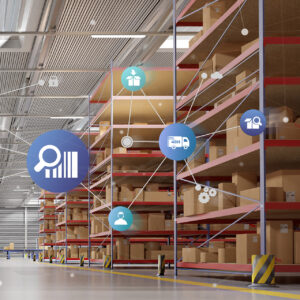When Hurricane Ian hit Florida, the forecasts were uncertain as to where it was going to cause the most damage. Ultimately, some businesses and the communities in which they operated were devastated while others were spared. This act of Mother Nature is a perfect example of why every business, including distributors, needs to have disaster planning in place, because you never know when, where, or how catastrophe might strike and imperil your organization, your income, your employees, and your customers.
Data Center Catalog found that “large enterprise businesses can expect downtime costing an average of $400,000 an hour”—a steep cost for not having a plan in place to mitigate potential effects of an unexpected event or disaster.
Business Continuity: What It Is and Why It’s Important
Business continuity is just what is sounds like: keeping a company functioning in the wake of a disaster or other unexpected event. Every business needs a plan to “keep the lights on,” so to speak, or there could be irreparable damage to revenue.
There is a difference between business continuity and disaster planning.
For example, during the early days of the COVID-19 pandemic in 2020, many distributors had to scramble and figure out how to do business remotely, from employees who could work at home and the tech they’d need to do that to the sales reps who could no longer visit a customer site.
Some distributors had plans in place and transitioned to a remote workforce and technology like video calling where they could. And some had already implemented online customer service options, including ecommerce, which helped them better support their customers.
No one could have predicted the hit we took when COVID arrived. But for those that already had some plans in place, there was no lost time trying to do all of this at the same time as others were.
And it seems the experience has had a positive long-term effect. “The latest BCI Continuity & Resilience Report 2022 found that most organizations are seeing resiliency processes become the norm,” according to the Business Continuity Institute (BCI). “Silos are dissolving, reporting lines to the C-suite are being reduced, and Business Continuity (BC) managers/Resilience managers are increasingly becoming a strategic part of organizational structures.”
Of course, while you need to be as ready as you can be for a big event like Hurricane Ian or COVID, any number of unexpected incidents could disrupt business: hurricane, flooding, power outage, cyberattack, sudden labor shortage, and more. Agility found in 2019 that “52% of businesses experienced a disruptive event(s) in the last five years.”
In other words, it could and probably has, happened to you.
What’s Included in a Business Continuity Plan?
When it comes time to develop your distribution company’s Business Continuity Plan, consider the following:
- What are the essential functions of the business? These should be priorities to keep going when disaster hits.
- What are some possible ways your business could be impacted? While you are preparing for the unknown, the fact is that it’s unlikely to be a blizzard in Florida or a hurricane in Montana. Consider disease outbreaks, cyberattacks, and common weather phenomenon for your area.
- Create a contact list and determine who is on it, who has access, and how they will access it in different scenarios.
- Make sure the plan has a guide for when to use it.
- The plan should incorporate specific ways you can support resilience, recovery, and contingency.
- Update the plan as key personnel change at the company.
Remember: Your goal is to reduce downtime and loss. Agility cites “the cost of business interruption varies from $5.8 million due to fire or explosion, $4.4 million due to a storm, or $0.55 million due to water damages. The longer the downtime, the higher the losses.”
What Should Distributors Include in a Disaster Recovery Planning Checklist?
Preparing for the unknown is a challenge, but it can be done successfully—and potentially save your business. Simply put, a disaster recovery plan is how you will respond if disaster hits. Here are a few inclusions:
- Establish an off-site phone service to use if the on-site switchboard could be damaged.
- If personnel could be at your facility during a disaster, there should be emergency supplies such as generators, flashlights, batteries, first aid kits, and more.
- Have a plan for mission-critical data and application restoration post-disaster. The cloud can play an important role in getting you back up quickly.
- Identify workflows that are dependent on other workflows, as well as processes in your organization that depend on external partners such as vendors.
- Create a way to communicate if systems go down. For example, if you typically use email, set up a text blast before you need it.
- Keep copies of key documents such as insurance policies in safe, separate location.
- Test and update your plan regularly, and update as needed.
The Role of Cloud Technology
One of the core elements of any Business Continuity Plan and disaster planning is to know how to reduce or prevent interruptions to the company’s critical services so that business doesn’t stop. For distributors, these include taking and fulfilling orders, maintaining warehouse operations, collaborating with manufacturers, and communicating with customers.
The costs of not having a plan and experiencing significant downtime include:
- lost revenue
- loss of reputation when customers orders go unfulfilled
- workforce shortage
- regulation consequences
- safety
- lost data
A cloud ERP can play a critical role in ensuring business operations keep rolling:
- Mission-critical data is in the cloud. Restore your critical data to any location to get systems back online quickly. If all your data is onsite, a fire or flood or other natural disaster could wipe out years of critical information for the business.
- Your team can keep working. When your team must be remote, they will still have access to necessary tools online so that operations continue seamlessly.
- Quick recovery. When you have equipment onsite that needs to be relocated and set up, that takes time you don’t have. With data and applications in the cloud, you can get back up and running even as quickly as the same day.
- Ensure security. The last thing you want to worry about when contending with the unexpected is your vulnerability. Cloud ERP solutions such as Dynamics 365 Finance and Supply Chain Management are highly secure, fed by billions of points of data that Microsoft uses to continually strengthen its systems.
Consider Microsoft Dynamics 365 Finance and Supply Chain Management to help with your Business Continuity Plan and disaster planning. Contact Sikich to learn how to assess your organization, build a plan for the unexpected, and strengthen your resiliency now.





